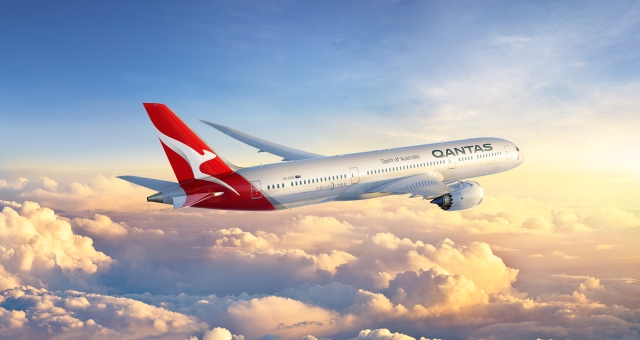Qantas has unveiled a new logo and has revealed what customers onboard its flagship 787-9 Dreamliner can expect when the aircraft arrives in a year’s time.
The Qantas Dreamliner will seat 236 passengers across Business, Premium Economy and Economy cabins in a layout that has been designed to maximise comfort for the longer distances the 787-9 is expected to fly.
The Business Suite is the next generation of the very popular seat recently installed on Qantas’ Airbus A330 fleet. These suites are known for providing a high level of privacy, made more flexible on the 787 with the ability to now adjust the divider between each seat.
The suites also have a fully-flat bed and offer plenty of space to eat, work or relax. Laid out in a 1-2-1 configuration, each suite has direct aisle access as well as the ability to stay reclined during take-off and landing.
Economy passengers will also have more room – including an extra inch of seat pitch compared with the national carrier’s A380 – and an all-new seat. It features a new personal device holder and USB ports; more storage areas; a seat-back mood light designed to minimise disturbance for other passengers; and a high-definition entertainment touchscreen that is five per cent larger.
The seats also feature an updated version of the popular Qantas ‘footnet’ first introduced on the A380, designed to cradle the legs during sleep.
Unveiling the Business and Economy seats in Sydney today, Qantas Group CEO, Alan Joyce, said the interiors had been carefully designed with longer routes and changing passenger preferences in mind.
“The Dreamliner is an aircraft built for comfort. The windows are bigger, it helps reduce jetlag, it’s extremely quiet and there’s a system that smooths out turbulence. Customers are going to love it,” he said.
“We’re planning to make the most of the 787’s amazing range, so we’ve designed the cabin to give Qantas passengers a better experience on long haul flights.
“Many of the cabin design elements reflect what our customers have told us. Personal storage rates really highly, so we’ve created extra space in Economy for customers to store their personal devices and water bottles.
“We’re proud that our new Economy seat includes features other carriers reserve for Premium Economy.
“We’re also redesigning the in-flight experience for the Dreamliner, from rethinking our menus to making better use of the self-service bars during different phases of flight,” Joyce said.
The Dreamliner cabin interiors and new economy seat, designed by Australian industrial designer David Caon, are a progression of the Qantas aesthetic established by Marc Newson.
Detail on initial Qantas Dreamliner destinations will be revealed in coming months, with the first international flights on sale before Christmas. The aircraft will gradually take over routes currently operated by the airline’s B747 fleet as well as adding new city-pairs to the Qantas International network.
The Dreamliner’s Premium Economy cabin, which will offer a class leading experience and a revolutionary new seat, will be unveiled in early 2017.
Qantas’ update to its iconic Kangaroo logo as part of preparation for the Boeing 787 Dreamliner entering its fleet a year from now is only the fifth time the red-and-white image on the tail of Qantas aircraft has been updated since it was first introduced in 1944.
The last update was in 2007 to coincide with the introduction of the Airbus A380 to the national carrier’s fleet.
“Since the image of a kangaroo first appeared on a Qantas aircraft more than 80 years ago, it’s come to represent the spirit of Australia. When passengers see the Qantas tail at airports around the world, it’s a symbol of home,” Joyce said.
“We wanted to make sure our brand remained familiar but we also wanted it to be more modern and dynamic, like the 787 and like Qantas.
“When we looked at the history, we found that the logo has been updated around the time of a game-changing new aircraft joining the fleet. It’s a tradition that goes back to the Lockheed Constellation in 1947, the B747-300 in 1984 and the A380 in 2007.
“A fresh brand helps symbolise the new era Qantas is entering as we head towards our centenary. It’s an era of new destinations, new technology and a new standard of service,” he said.
The new design was overseen by Qantas consultant designer, Marc Newson, in partnership with Australian design agency Houston Group.
“Aircraft tails are fantastic canvas to work on and the Qantas logo is one of the most recognisable in the world. This re-design aims to retain the fundamental essence of the flying kangaroo but also move the brand forward,” Newson said.
“This new brand is more streamlined and the shading behind the kangaroo gives a better sense of movement and depth. A silver band now extends from the tail to the rear of the fuselage, to give a more premium feel.
“The typography for the word Qantas, which measures almost two metres high on the 787, has been carefully streamlined. And Qantas will appear on the aircraft’s belly, so you can tell when it’s the national carrier flying overhead,” he said.
In another link to the airline’s heritage, the classic winged kangaroo that appeared on tails across three decades will feature under the cockpit window and incorporate the individual name of each aircraft.
The new design will gradually appear across the Qantas network from today, starting with digital assets, signage and advertising. Inventory of other items – such as pyjamas – has been run down in preparation for the new logo. Updating branding on aircraft will be sequenced with scheduled re-paints, to be completed in time for the airline’s centenary in 2020.
The updated brand follows the introduction of new cabin crew uniforms in 2014 and new pilot uniforms, unveiled earlier this year, that rolled out yesterday.




